Have you tried to open a well-known web page and found that the Google Chrome, Firefox, Edge and Internet Explorer are being redirected to the site called Updates Recommended? If you answered ‘Yes’ then your need to know that the “Updates Recommended” is a misleading advertising created to trick you into installing an questionable software. If your browser constantly opens to the “Updates Recommended” scam, then it is sign that your browser is affected by an adware (also known as ad-supported software). The adware is a type of malicious software that alters your personal computer’s browser settings so that you’ll be randomly re-directed to various undesired advertisements. Use the step-by-step guide below sooner It’ll clean your computer from the adware and thus get rid of annoying “Updates Recommended” pop up ads. Moreover, the tutorial will help you to protect your system from more harmful viruses and trojans.
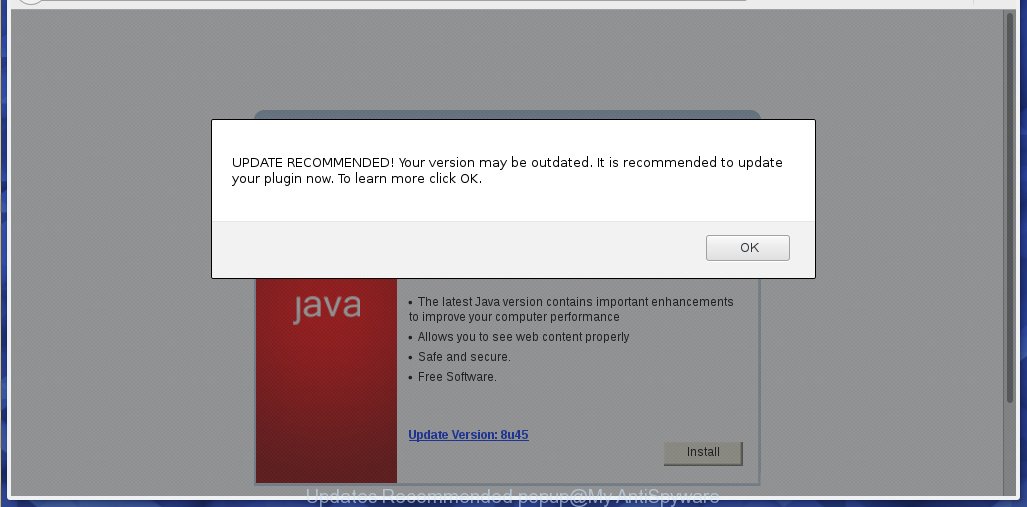
“Updates Recommended” popup is a misleading advertising
While your machine is affected with the adware, the Google Chrome, Firefox, MS Edge and Microsoft Internet Explorer may be rerouted to “Updates Recommended” undesired site. Of course, the adware may not cause damages to your files or Windows system, but it may display a large number of intrusive ads. These advertisements will be injected within the content of web-pages that are you opening in your web browser and can be varied: pop-up ads, in-text ads, different sized banners, offers to install an questionable software. The ads will appear on all sites, including web-pages where previously you have never seen any advertising links.
Most often, the ad-supported software infects the most common web browsers such as the Firefox, Google Chrome, Internet Explorer and MS Edge. But such the harmful software as well may infect another web-browsers by modifying its shortcuts (adding an argument such as ‘http://site.address’ into Target field of a internet browser’s shortcut). So every time you open the web-browser, it’ll reroute to the undesired “Updates Recommended” web site. Even if you setup a new homepage, an annoying web-site will be the first thing you see when you launch the Mozilla Firefox, Chrome, Internet Explorer and Microsoft Edge.
We strongly advise that you perform the few simple steps below which will help you to get rid of “Updates Recommended” fake alerts using the standard features of Windows and some proven free software.
How to remove “Updates Recommended” pop up scam
As with deleting adware, malicious software or potentially unwanted software, there are few steps you may do. We advise trying them all. If you do only one part of the tutorial, then it should be run malicious software removal utility, because it should remove adware and stop any further infection. But to completely delete “Updates Recommended” popup scam you’ll have to at least reset your web browser settings like new tab page, start page and search provider by default to default state, disinfect PC’s browsers shortcuts, delete all unwanted and suspicious software, and get rid of ad supported software with malware removal utilities. Read this manual carefully, bookmark or print it, because you may need to exit your internet browser or restart your PC.
To remove “Updates Recommended”, complete the following steps:
- How to manually remove “Updates Recommended”
- Deleting the “Updates Recommended”, check the list of installed applications first
- Remove unwanted Scheduled Tasks
- Remove “Updates Recommended” fake alerts from Google Chrome
- Get rid of “Updates Recommended” from FF by resetting web browser settings
- Remove “Updates Recommended” pop up warnings from Microsoft Internet Explorer
- Disinfect the internet browser’s shortcuts to remove “Updates Recommended” redirect
- How to automatically delete “Updates Recommended” pop up warnings
- How to block “Updates Recommended” popup
- How did “Updates Recommended” pop-up warnings get on your machine
- To sum up
How to manually remove “Updates Recommended”
Read this “How to remove” section to know how to manually remove ‘ad supported’ software which shows misleading “Updates Recommended” fake alerts on your personal computer. Even if the step by step guide does not work for you, there are several free malware removers below that can easily handle such ‘ad supported’ software which causes misleading “Updates Recommended” fake alerts on your web-browser.
Deleting the “Updates Recommended”, check the list of installed applications first
The best way to start the computer cleanup is to remove unknown and suspicious apps. Using the MS Windows Control Panel you can do this quickly and easily. This step, in spite of its simplicity, should not be ignored, because the removing of unneeded programs can clean up the Google Chrome, IE, Mozilla Firefox and Edge from advertisements, hijackers and so on.
Windows 8, 8.1, 10
First, click Windows button

Once the ‘Control Panel’ opens, click the ‘Uninstall a program’ link under Programs category like below.

You will see the ‘Uninstall a program’ panel as shown in the following example.

Very carefully look around the entire list of applications installed on your PC. Most probably, one of them is the ad-supported software that causes multiple misleading “Updates Recommended” alerts and pop ups. If you’ve many applications installed, you can help simplify the search of malicious apps by sort the list by date of installation. Once you have found a suspicious, unwanted or unused program, right click to it, after that click ‘Uninstall’.
Windows XP, Vista, 7
First, click ‘Start’ button and select ‘Control Panel’ at right panel as shown on the screen below.

After the Windows ‘Control Panel’ opens, you need to press ‘Uninstall a program’ under ‘Programs’ as displayed in the following example.

You will see a list of apps installed on your PC system. We recommend to sort the list by date of installation to quickly find the apps that were installed last. Most probably, it is the adware which cause misleading “Updates Recommended” pop up warnings to appear. If you’re in doubt, you can always check the program by doing a search for her name in Google, Yahoo or Bing. After the application which you need to uninstall is found, simply click on its name, and then click ‘Uninstall’ as displayed in the following example.

Remove unwanted Scheduled Tasks
If the undesired “Updates Recommended” web site opens automatically on Windows startup or at equal time intervals, then you need to check the Task Scheduler Library and remove all the tasks which have been created by malicious application.
Press Windows and R keys on the keyboard simultaneously. This shows a prompt that titled with Run. In the text field, type “taskschd.msc” (without the quotes) and click OK. Task Scheduler window opens. In the left-hand side, click “Task Scheduler Library”, as on the image below.
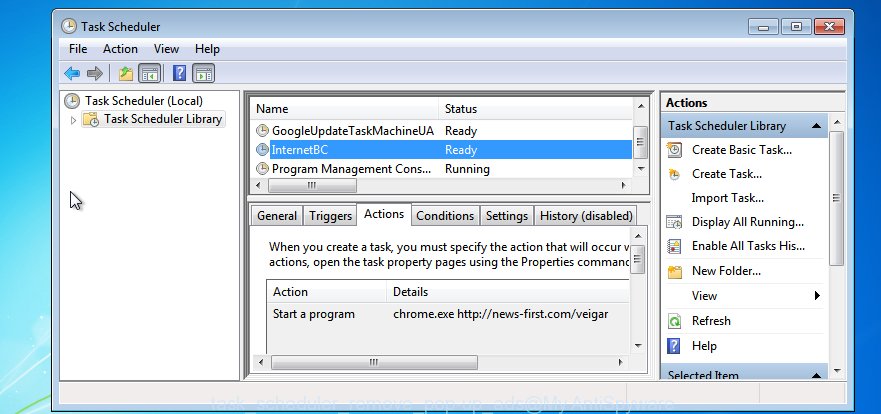
Task scheduler
In the middle part you will see a list of installed tasks. Please choose the first task, its properties will be open just below automatically. Next, press the Actions tab. Pay attention to that it launches on your system. Found something like “explorer.exe http://site.address” or “chrome.exe http://site.address”, then remove this harmful task. If you are not sure that executes the task, check it through a search engine. If it’s a component of the adware, then this task also should be removed.
Having defined the task that you want to remove, then click on it with the right mouse button and choose Delete as on the image below.

Delete a task
Repeat this step, if you have found a few tasks which have been created by ‘ad-supported’ application. Once is finished, close the Task Scheduler window.
Remove “Updates Recommended” fake alerts from Google Chrome
Run the Reset web browser utility of the Google Chrome to reset all its settings such as startpage, newtab page and default search engine to original defaults. This is a very useful utility to use, in the case of internet browser redirects to annoying ad web-sites like “Updates Recommended”.
First run the Chrome. Next, click the button in the form of three horizontal dots (![]() ).
).
It will show the Google Chrome menu. Select More Tools, then click Extensions. Carefully browse through the list of installed extensions. If the list has the add-on signed with “Installed by enterprise policy” or “Installed by your administrator”, then complete the following guidance: Remove Chrome extensions installed by enterprise policy.
Open the Google Chrome menu once again. Further, press the option called “Settings”.

The web-browser will open the settings screen. Another method to show the Google Chrome’s settings – type chrome://settings in the web browser adress bar and press Enter
Scroll down to the bottom of the page and click the “Advanced” link. Now scroll down until the “Reset” section is visible, as displayed below and click the “Reset settings to their original defaults” button.

The Chrome will display the confirmation dialog box like below.

You need to confirm your action, press the “Reset” button. The browser will start the procedure of cleaning. When it is done, the web browser’s settings including start page, newtab and default search provider back to the values which have been when the Google Chrome was first installed on your computer.
Get rid of “Updates Recommended” from FF by resetting web browser settings
The Firefox reset will keep your personal information such as bookmarks, passwords, web form auto-fill data, recover preferences and security settings, remove redirections to undesired “Updates Recommended” site and adware.
Launch the Firefox and click the menu button (it looks like three stacked lines) at the top right of the browser screen. Next, click the question-mark icon at the bottom of the drop-down menu. It will display the slide-out menu.
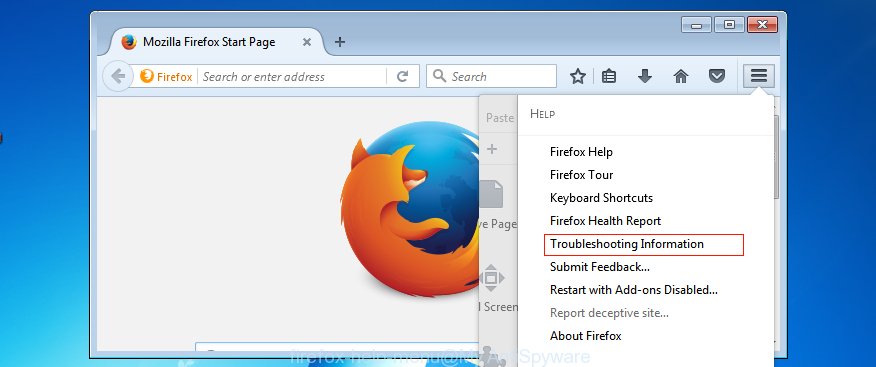
Select the “Troubleshooting information”. If you’re unable to access the Help menu, then type “about:support” in your address bar and press Enter. It bring up the “Troubleshooting Information” page as shown on the screen below.
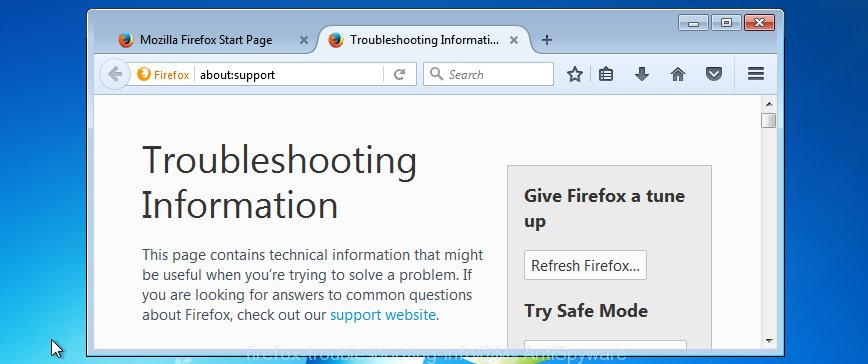
Click the “Refresh Firefox” button at the top right of the Troubleshooting Information page. Select “Refresh Firefox” in the confirmation dialog box. The FF will begin a process to fix your problems that caused by the adware that cause misleading “Updates Recommended” fake alerts to appear. Once, it is done, press the “Finish” button.
Remove “Updates Recommended” pop up warnings from Microsoft Internet Explorer
By resetting IE web-browser you restore your internet browser settings to its default state. This is basic when troubleshooting problems that might have been caused by ad supported software that causes multiple misleading “Updates Recommended” alerts and pop-ups.
First, run the Internet Explorer, then press ‘gear’ icon ![]() . It will show the Tools drop-down menu on the right part of the web browser, then click the “Internet Options” as displayed on the screen below.
. It will show the Tools drop-down menu on the right part of the web browser, then click the “Internet Options” as displayed on the screen below.

In the “Internet Options” screen, select the “Advanced” tab, then click the “Reset” button. The Internet Explorer will open the “Reset Internet Explorer settings” prompt. Further, click the “Delete personal settings” check box to select it. Next, click the “Reset” button as displayed on the screen below.

After the process is done, click “Close” button. Close the Internet Explorer and reboot your PC system for the changes to take effect. This step will help you to restore your web-browser’s new tab page, startpage and search provider by default to default state.
Disinfect the internet browser’s shortcuts to remove “Updates Recommended” redirect
When the ad supported software is started, it can also change the internet browser’s shortcut files, adding an argument such as “http://site.address” into the Target field. Due to this, every time you launch the browser, it will open an intrusive site.
To clear the internet browser shortcut file, right-click to it and choose Properties. On the Shortcut tab, locate the Target field. Click inside, you will see a vertical line – arrow pointer, move it (using -> arrow key on your keyboard) to the right as possible. You will see a text such as “http://site.address” which has been added here. You need to delete it.

When the text is removed, press the OK button. You need to clean all shortcut files of all your web-browsers, as they may be affected too.
How to automatically delete “Updates Recommended” pop up warnings
The ‘ad supported’ software can hide its components which are difficult for you to find out and remove completely. This can lead to the fact that after some time, the ‘ad supported’ software that causes misleading “Updates Recommended” fake alerts on your browser again infect your computer. Moreover, We want to note that it is not always safe to delete adware manually, if you don’t have much experience in setting up and configuring the Microsoft Windows operating system. The best method to find out and remove adware is to run free malware removal apps.
How to automatically delete “Updates Recommended” fake alerts with Zemana Anti-malware
We recommend you to run the Zemana Anti-malware that are completely clean your personal computer of adware that designed to show misleading “Updates Recommended” popup warnings within your browser. Moreover, the tool will allow you to get rid of potentially unwanted software, malicious software, toolbars and browser hijackers that your computer can be infected too.
Download Zemana Free from the following link. Save it on your Desktop.
164780 downloads
Author: Zemana Ltd
Category: Security tools
Update: July 16, 2019
When the download is finished, start it and follow the prompts. Once installed, the Zemana Anti-Malware will try to update itself and when this task is complete, press the “Scan” button for checking your machine for the adware that causes misleading “Updates Recommended” fake alerts on your browser.

When a threat is detected, the number of the security threats will change accordingly. Wait until the the checking is done. When you are ready, press “Next” button.

The Zemana AntiMalware (ZAM) will remove adware that shows misleading “Updates Recommended” fake alerts on your PC.
How to automatically delete “Updates Recommended” with Malwarebytes
Remove “Updates Recommended” pop-up scam manually is difficult and often the adware is not completely removed. Therefore, we recommend you to run the Malwarebytes Free that are completely clean your computer. Moreover, the free program will allow you to remove malicious software, PUPs, toolbars and browser hijacker infections that your PC system can be infected too.
Click the following link to download the latest version of MalwareBytes for Windows. Save it to your Desktop so that you can access the file easily.
327040 downloads
Author: Malwarebytes
Category: Security tools
Update: April 15, 2020
Once the download is done, close all windows on your system. Further, start the file named mb3-setup. If the “User Account Control” dialog box pops up like below, click the “Yes” button.

It will display the “Setup wizard” that will allow you setup MalwareBytes on the computer. Follow the prompts and don’t make any changes to default settings.

Once installation is finished successfully, click Finish button. Then MalwareBytes Anti Malware (MBAM) will automatically run and you can see its main window as displayed below.
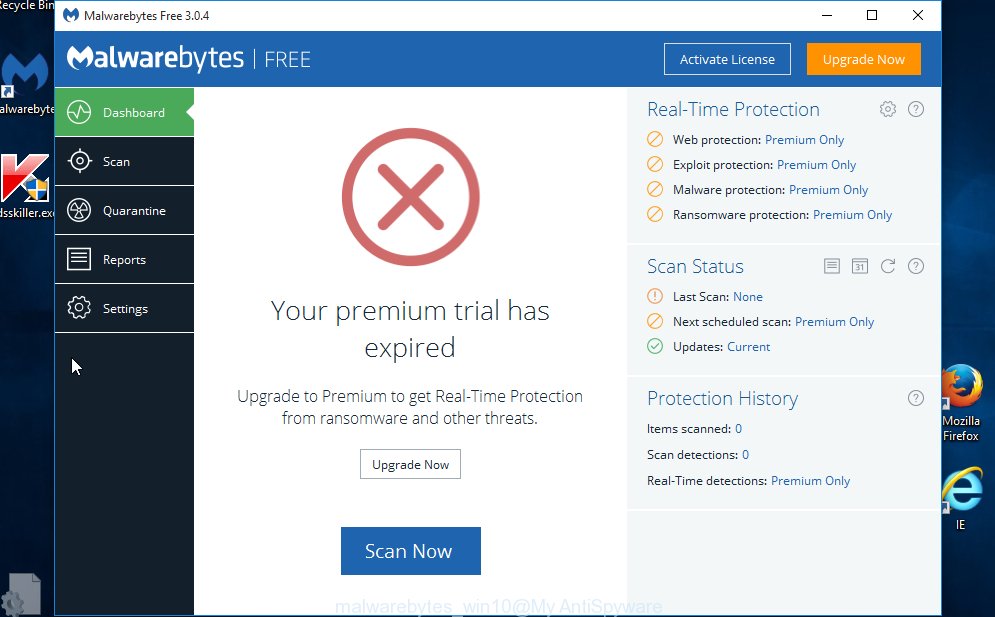
Next, press the “Scan Now” button . MalwareBytes Anti-Malware (MBAM) utility will begin scanning the whole personal computer to find out ad supported software that displays misleading “Updates Recommended” fake alerts on your personal computer. A scan can take anywhere from 10 to 30 minutes, depending on the number of files on your computer and the speed of your machine. When a threat is found, the number of the security threats will change accordingly. Wait until the the checking is complete.
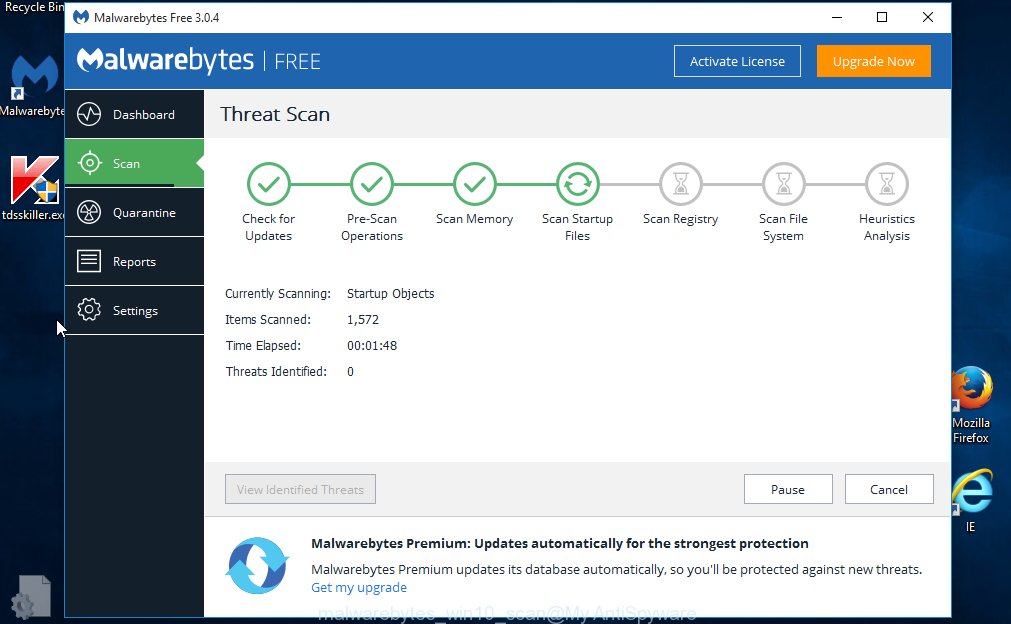
When the scan get completed, MalwareBytes AntiMalware will display a list of all threats detected by the scan. Make sure all items have ‘checkmark’ and click “Quarantine Selected” button.

The MalwareBytes Free will start to remove ad supported software that causes multiple misleading “Updates Recommended” alerts and pop-ups. When that process is finished, you may be prompted to reboot your system. We recommend you look at the following video, which completely explains the procedure of using the MalwareBytes to remove browser hijacker infections, adware and other malicious software.
Double-check for potentially unwanted applications with AdwCleaner
AdwCleaner is a free tool which can scan for adware that causes multiple misleading “Updates Recommended” alerts and pop-ups. It is not always easy to locate all the junk applications that your computer might have picked up on the Internet. AdwCleaner will find out the ad-supported software, hijackers and other malicious software you need to uninstall.
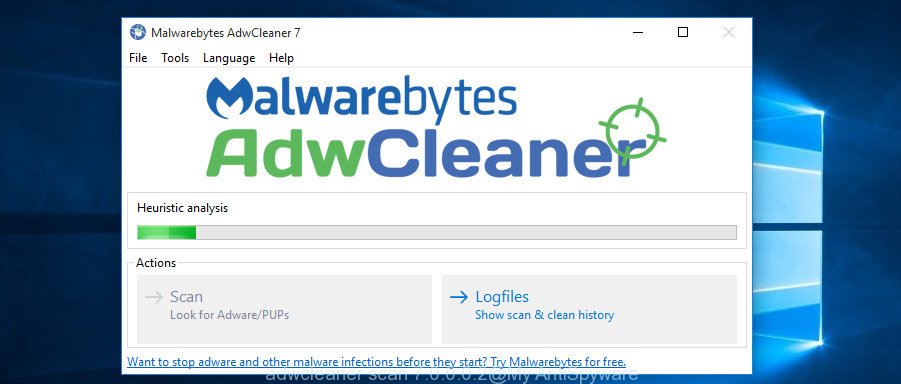
- Please go to the link below to download the latest version of AdwCleaner for Microsoft Windows. Save it on your Windows desktop or in any other place.
AdwCleaner download
225533 downloads
Version: 8.4.1
Author: Xplode, MalwareBytes
Category: Security tools
Update: October 5, 2024
- Select the file location as Desktop, and then press Save.
- After the download is finished, start the AdwCleaner, double-click the adwcleaner_xxx.exe file.
- If the “User Account Control” prompts, click Yes to continue.
- Read the “Terms of use”, and click Accept.
- In the AdwCleaner window, click the “Scan” for scanning your computer for the ‘ad supported’ software that causes web browsers to open misleading “Updates Recommended” popup warnings. This process can take some time, so please be patient. When a threat is found, the number of the security threats will change accordingly.
- After the scanning is finished, you’ll be displayed the list of all detected threats on your PC. You may move items to Quarantine (all selected by default) by simply press “Clean”. If the AdwCleaner will ask you to reboot your machine, click “OK”.
The steps shown in detail in the following video.
How to block “Updates Recommended” popup
Use ad-blocking application like AdGuard in order to block ads, malvertisements, pop-ups and online trackers, avoid having to install malicious and adware browser plug-ins and add-ons that affect your PC performance and impact your computer security. Surf the Net anonymously and stay safe online!
- Download AdGuard program from the following link. Save it on your Desktop.
Adguard download
26839 downloads
Version: 6.4
Author: © Adguard
Category: Security tools
Update: November 15, 2018
- When the download is finished, run the downloaded file. You will see the “Setup Wizard” program window. Follow the prompts.
- Once the installation is complete, click “Skip” to close the install program and use the default settings, or click “Get Started” to see an quick tutorial that will allow you get to know AdGuard better.
- In most cases, the default settings are enough and you do not need to change anything. Each time, when you start your system, AdGuard will start automatically and block pop-ups, web pages such “Updates Recommended”, as well as other harmful or misleading web pages. For an overview of all the features of the program, or to change its settings you can simply double-click on the icon named AdGuard, that can be found on your desktop.
How did “Updates Recommended” pop-up warnings get on your machine
The adware come bundled with various free applications, as a supplement, which is installed automatically. This is certainly not an honest way to get installed onto your PC system. To avoid infecting of your computer and side effects in the form of unwanted “Updates Recommended” pop ups, you should always carefully read the Terms of Use and the Software license. Additionally, always choose Manual, Custom or Advanced installation type. This allows you to disable the install of unnecessary and often harmful apps. Even if you uninstall the free applications from your personal computer, this ‘ad supported’ software will not be fully removed. This means that you should manually get rid of ad-supported software that causes multiple misleading “Updates Recommended” alerts and popups by follow the few simple steps above.
To sum up
Once you have done the step-by-step tutorial above, your system should be clean from adware that made to show misleading “Updates Recommended” pop-up warnings within your web browser and other malicious software. The Google Chrome, Microsoft Internet Explorer, Mozilla Firefox and MS Edge will no longer redirect you to various unwanted sites such as “Updates Recommended”. Unfortunately, if the step by step tutorial does not help you, then you have caught a new adware, and then the best way – ask for help in our Spyware/Malware removal forum.




















